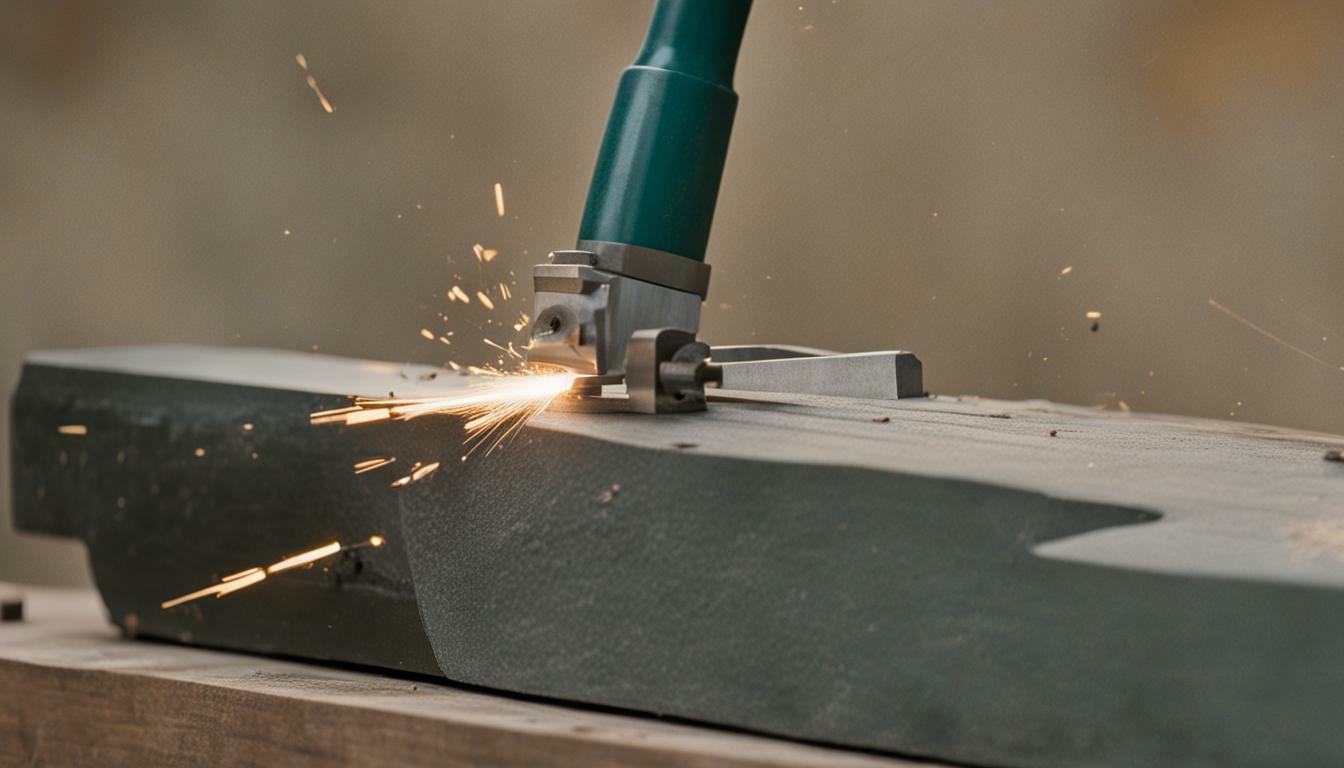
Lathe tools are essential for turning wood, but over time, their cutting edges can become dull and inefficient. Sharpening lathe tools is essential for achieving precise cuts and prolonging the life of your tools. In this guide, we will provide you with a comprehensive overview of lathe tool sharpening techniques, from understanding the basics to advanced tips.
Key Takeaways:
- Sharpening lathe tools is essential for achieving precise cuts and prolonging their lifespan.
- This guide will cover the basics of lathe tool sharpening, equipment selection, step-by-step instructions, common mistakes to avoid, and advanced techniques to take your skills to the next level.
- By following the guidelines and tips provided in this guide, you can enhance your woodturning experience and achieve optimal performance from your lathe tools.
Understanding the Basics of Lathe Tool Sharpening
Sharpening lathe tools is a crucial skill for any woodworker looking to achieve precise cuts and ensure the longevity of their tools. In this guide, we will cover the basics of lathe tool sharpening and provide you with the knowledge needed to master this skill.
Key Components of a Lathe Tool
A lathe tool consists of three basic components: the shank, the blade, and the cutting edge. The shank is the part of the tool that attaches to the lathe. The blade is the portion that extends from the shank and features the cutting edge. The cutting edge is the business end of the tool and is responsible for removing material from the workpiece.
It is important to understand the anatomy of a lathe tool to properly sharpen it and maintain its cutting edge.
The Benefits of Maintaining a Sharp Cutting Edge
Maintaining a sharp cutting edge is crucial to achieving precise cuts and improving your woodworking experience. A sharp cutting edge will reduce the amount of force needed to make cuts, decrease the likelihood of the tool jumping or catching, and produce a smoother finish on the workpiece.
Furthermore, keeping the cutting edge sharp will extend the lifespan of the lathe tool, saving you time and money in the long run.
Lathe Tool Sharpening Guide
When sharpening a lathe tool, it is important to follow a consistent and precise process to ensure optimal results. This guide will walk you through the fundamental steps of lathe tool sharpening:
- Clean the lathe tool to remove any debris or grime.
- Secure the lathe tool in a vice or jig to prevent movement during sharpening.
- Select the appropriate sharpening equipment, such as a grinding wheel or bench grinder.
- Determine the correct angles for the cutting edge based on the type of lathe tool and the material being worked on.
- Begin sharpening the lathe tool, starting with the rough grinding and moving on to honing the cutting edge.
- Test the sharpness of the lathe tool by making a few light cuts on a scrap piece of wood.
By following these steps and practicing regularly, you can master the skill of lathe tool sharpening and improve your woodworking abilities.
Choosing the Right Sharpening Equipment for Lathe Tools
When it comes to sharpening lathe chisels, choosing the right equipment is crucial for achieving the best results. Let’s take a closer look at the different options available:
| Equipment | Pros | Cons |
|---|---|---|
| Grinding Wheels |
|
|
| Bench Grinders |
|
|
| Sharpening Jigs |
|
|
Ultimately, the best option for you will depend on your budget, the type of lathe chisel you’re sharpening, and your personal preferences. Some woodworkers prefer to use a combination of different sharpening equipment to achieve the best results.
Remember, whether you choose a grinding wheel, bench grinder, or sharpening jig, make sure to follow the manufacturer’s instructions carefully to ensure proper usage and safety.
Step-by-Step Guide to Sharpening Lathe Tools
Sharpening lathe tools is an essential skill for any woodworker or machinist. A sharp cutting edge is key to achieving precise cuts and maximizing the lifespan of your lathe tools. Follow these step-by-step instructions to sharpen your lathe tools efficiently and effectively.
Prepare the Tool
Before you begin sharpening, it’s important to inspect the tool for any damage or wear and tear. If the tool is damaged, it should be repaired or replaced before sharpening. Once the tool is ready, clean it with a wire brush or sandpaper to remove any rust or debris. Secure the tool in a vise or holding jig to keep it stable during sharpening.
Set the Angles
The next step is to set the correct angles for your lathe tool. This will depend on the type of tool and the material you will be cutting. Use a protractor or angle gauge to measure the angles of the existing edge, or refer to manufacturer’s guidelines for recommended angles. The most common angles for lathe tools are 60° for general-purpose cutting and 30° for finishing cuts.
Hone the Cutting Edge
Using a sharpening stone, sharpening jig, or bench grinder, carefully sharpen the cutting edge of the tool. Start with the coarsest grit and gradually move to finer grits until you achieve the desired sharpness. Keep the tool at the correct angle and apply even pressure to achieve a consistent edge. Take breaks as needed to prevent overheating the tool.
Test the Edge
After honing the cutting edge, test the sharpness by making a test cut on scrap material. The tool should produce clean, smooth cuts without tearing or splintering the wood. If the tool is not sharp enough, repeat the sharpening process with a finer grit.
With practice, you’ll be able to sharpen your lathe tools efficiently and effectively, ensuring a sharp cutting edge for precise cuts and longevity.
Common Mistakes to Avoid When Sharpening Lathe Tools
Sharpening lathe tools is a crucial skill for any woodworker. However, even the most experienced craftsmen can make mistakes that affect the quality of their work. Here are some common mistakes to avoid when sharpening lathe tools:
- Skipping the grinding step: Some novice woodworkers assume that honing alone is enough to sharpen a lathe tool. However, if the tool is not properly shaped with a grinder, the honing process will not be effective.
- Using the wrong grinding wheel: Different types of lathe tools require different grinding wheels. Using the wrong one can result in a damaged tool or an inefficient sharpening process.
- Overheating the tool: When grinding, it is important to cool the tool down frequently to prevent overheating. Overheating can cause the tool to lose its temper, making it too brittle to use effectively.
- Incorrect angles: Setting the wrong angles when sharpening lathe tools can result in poor cutting performance and premature dulling of the tool.
To avoid these mistakes, take your time and follow a proper sharpening process. Use the appropriate equipment and always pay attention to the angles and temperature of the tool. With practice and patience, you will be able to sharpen your lathe tools like a pro.
Maintaining a Sharp Cutting Edge for Longevity
Proper maintenance of your sharpened lathe tools is essential for long-term performance and longevity. Here are some tips to keep your tools in top shape:
- After use, clean the tools with a fine brush and a cloth to remove any debris or wood shavings.
- Store the tools in a dry place to prevent rust buildup.
- Regularly inspect the cutting edge for any signs of wear or damage.
- If the edge becomes dull, re-sharpen it as soon as possible to prevent further damage.
By following these maintenance routines, you can extend the life of your sharpened lathe tools and maintain their cutting performance.
Remember, a sharp cutting edge is crucial for achieving precise cuts and maximizing the lifespan of your lathe tools.
Advanced Techniques for Lathe Tool Sharpening
For woodworkers who are looking to take their lathe tool sharpening skills to the next level, there are advanced techniques that can be utilized to achieve the desired results. These techniques include customizing tool shapes, utilizing specialized grinding wheels, and honing micro bevels.
Customizing Tool Shapes
One of the benefits of sharpening your own lathe tools is the ability to customize their shapes to fit specific applications. By grinding the tool to a unique shape, you can achieve the desired cut and finish. For example, a bowl gouge can be shaped to have a more swept-back grind to allow for deeper cuts without the risk of the tool getting caught in the wood.
Utilizing Specialized Grinding Wheels
There are various types of grinding wheels available that can enhance the sharpening process. For example, a diamond grinding wheel can be used to produce a super-sharp cutting edge, while a ceramic grinding wheel can provide a cooler, more efficient grinding process. It’s essential to choose the right wheel for the task at hand and to maintain the correct speed and pressure during grinding.
Honing Micro Bevels
A micro bevel is a small secondary bevel that is added to a cutting edge to provide additional support and improve its durability. Honing a micro bevel involves using a honing guide to maintain the correct angle and polishing the edge with a fine abrasive material. This technique can help to extend the life of your sharpened tools and improve their performance.
By mastering these advanced techniques, you can achieve even greater precision and efficiency in your woodworking projects. Remember to always take the necessary safety precautions when working with sharpening equipment to avoid injury.
Conclusion
In conclusion, the process of sharpening lathe tools can seem daunting at first, but with the right knowledge and tools, it can be a simple and rewarding experience. By understanding the basics of lathe tool sharpening, choosing the right equipment, following a step-by-step guide, avoiding common mistakes, and maintaining the cutting edge, you can produce precise cuts and extend the lifespan of your lathe tools.
Remember, practice makes perfect, and as you become more experienced, you can experiment with advanced techniques to further enhance your woodworking skills. With patience and dedication, you can sharpen lathe tools efficiently and achieve great results in your woodworking projects.
FAQ
Q: What are the benefits of sharpening lathe tools?
A: Sharpening lathe tools allows for precise cuts, enhances the performance of the tool, and increases its lifespan.
Q: What are the key components of a lathe tool?
A: The key components of a lathe tool include the tool bit, tool shank, and handle.
Q: What sharpening equipment options are available for lathe tools?
A: There are various options for sharpening lathe tools, including grinding wheels, bench grinders, and sharpening jigs.
Q: What is the step-by-step process of sharpening lathe tools?
A: The process involves preparing the tool, setting the angles, and honing the cutting edge.
Q: What are some common mistakes to avoid when sharpening lathe tools?
A: Some common mistakes to avoid include improper angle settings, excessive grinding, and neglecting regular maintenance.
Q: How can I maintain a sharp cutting edge for my lathe tools?
A: Regular maintenance routines, such as honing and proper storage, are essential for maintaining a sharp cutting edge.
Q: Are there any advanced techniques for lathe tool sharpening?
A: Yes, advanced techniques include customizing tool shapes, utilizing specialized grinding wheels, and honing micro bevels.
- Delta Midi Lathe 46-250 Performance - August 27, 2023
- Understanding the Different Parts of a Lathe Machine - August 27, 2023
- Explore Different Lathe Tool Holder Types for Your Projects - August 27, 2023
